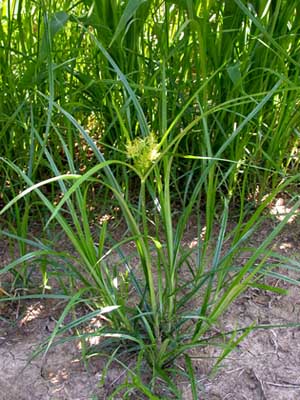
Yellow nutsedge (Courtesy Cornell University)
Yellow nutsedge can be a particular difficult weed to control in Northeast vineyards because of its below-ground germinating tuber, though the weed tends to disappear once a vineyard is established.
Dr. Andy Senesac, Cornell University/Long Island Extension weed specialist, said the best strategy is to use pre-emergents.
The newest tool available, and also the most potent, is Zeus Prime XC (sulfentrazone). Solicam (norflurazon) and Devrinol (napropamide) also have indicated activity against the weed.
Another herbicide that can be effective is Matrix (rimsulfuron), Senesac said, which is labeled for potatoes, tomatoes and grapes.
However, it is notorious for not getting into the plant when applied without an adjuvant. “You’ll lose 20 percent of the control without one,” he said.
The herbicide also shows some activity against hedge bindweed, though the compound is not labeled for use against it.
Thinking the need for adjuvants carried over to hedge bindweed, Senesac, conducted a trial applying Matrix to 6- and 12-inch hedge bindweed stands.
At various application rates with and without non-ionic surfactants, Senesac achieved 31 percent control without adjuvants and control ranging from 74 percent to 99 percent with adjuvants.
In a laboratory study, he evaluated hedge bindweed control using Matrix and Chateau and a combination of non-ionic surfactant, methylated seed oil and spray-grade ammonium sulfate as adjuvants.
Senesac found Matrix, used in combination with adjuvants, would suppress the weed’s growth.
– by Dave Weinstock






Leave A Comment